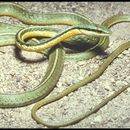en
names in breadcrumbs


Leptophis diplotropis, commonly known as the Pacific Coast parrot snake, is a species of snake in the family Colubridae.[5] The species is endemic to Mexico.[1]
The geographic range of L. diplotropis in Mexico extends from southwestern Chihuahua and southern Sonora to southeastern Oaxaca.
Dorsally, L. diplotropis is green (which fades to blue in alcohol) with black and white striping. Ventrally, it is white. Males may attain a snout-to-vent length (SVL) of 90 cm (35 in) plus a tail length of 51 cm (20 in). Females, which are smaller, may attain 73 cm (29 in) SVL plus a 37 cm (15 in) tail. It has on average 19 maxillary teeth, of which the rearmost two are strongly enlarged.[3]
There are two recognized subspecies, including the nominate race.
Nota bene: A trinomial authority in parentheses indicates that the subspecies was originally described in a genus other than Leptophis.
The subspecific name, forreri, is in honor of Alphonse Forrer (1836–1899), an English-born collecter of zoological specimens in Mexico for the British Museum.[6]
L. diplotropis is found in tropical dry forest, semi-deciduous forest, mangrove forest, oak forest and wet forest, from sea level up to 1,600 m (5,200 ft). It is a highly adaptable species, which is also found in disturbed areas.[1]
L. diplotropis is diurnal and mostly arboreal.[7]
L. diplotropis preys predominately upon frogs (genera Agalychnis, Lithobates, Smilisca, Tlalocohyla, Trachycephalus) and lizards (genus Phyllodactylus).[7]
L. diplotropis is oviparous.[4]
Leptophis diplotropis, commonly known as the Pacific Coast parrot snake, is a species of snake in the family Colubridae. The species is endemic to Mexico.